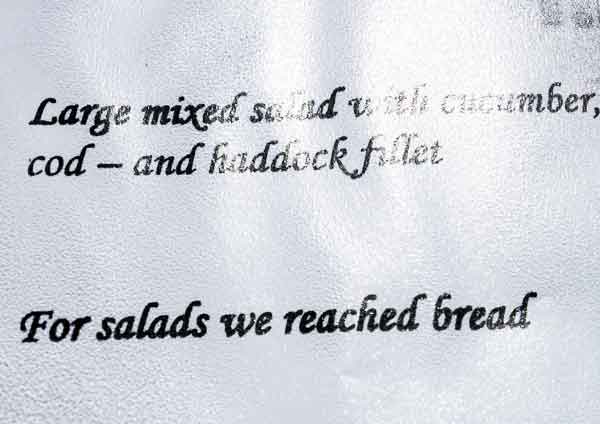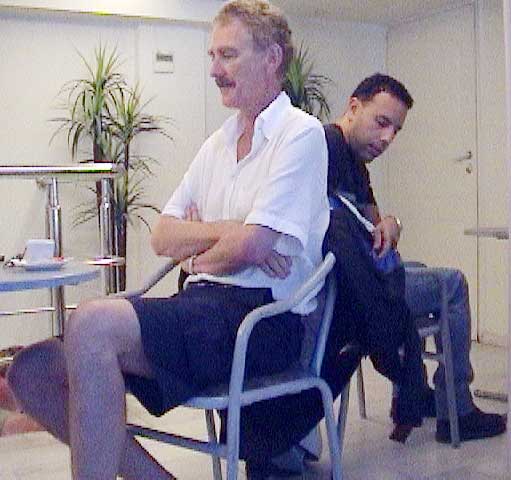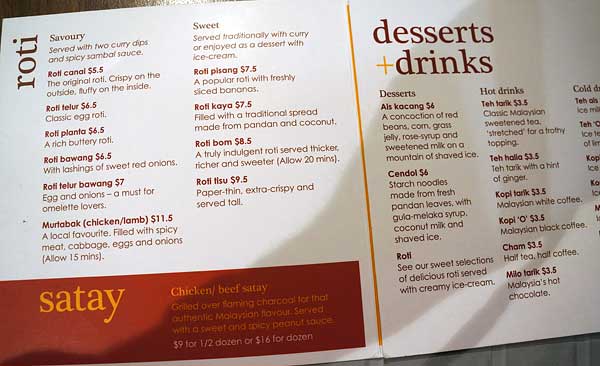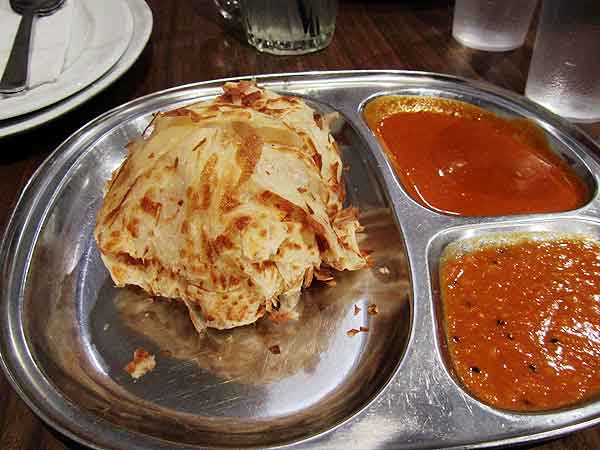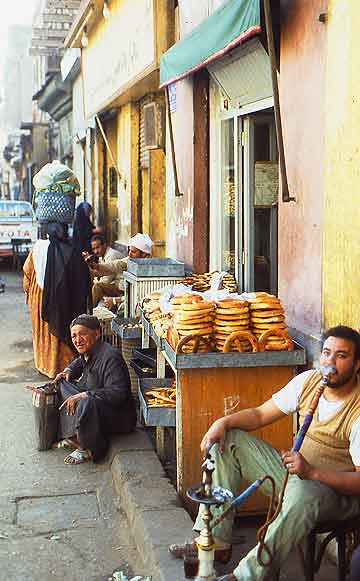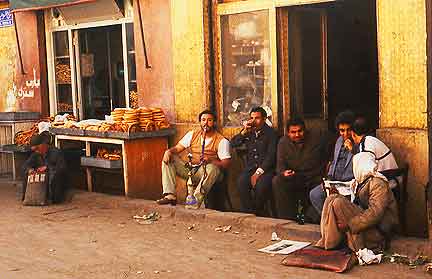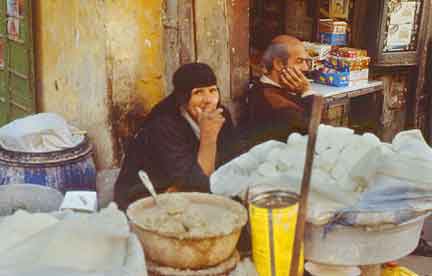Kajsas fish soup, Stockholm
Kajsas fish soup

I dream of Kajsas’ fish soup! Since I started visiting Kajsas Fiskbistron (fish bistro) in the 90s, I always order only that. It’s a hearty red broth stocked with fish like a dude ranch pond. Miraculously, the large tender filets are boneless.
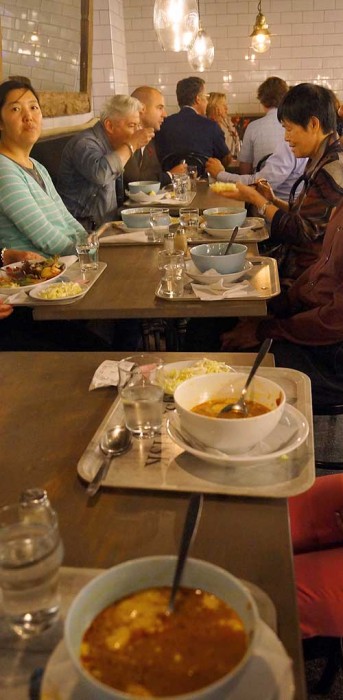
When you order, you say yes or no to additional spoonfuls of cooked shrimp (yes!), shelled mussels (yes!), and aioli (absolutely!). Then you add your own double-dollop of harissa (spicy Moroccan chili paste) (essential!). Feast in a bowl!
The free “salad,” on my last visit a few days ago, was shredded napa cabbage, a nice, crunchy complement. I seem to remember other simple salads on other visits, but you don’t go for the salad. Bread is included, and so is water.
You can order other seafood dishes, but why? Plenty of tasty choices are on the blackboard menu, but only a few people seem to order them. They must be frequent visitors who work nearby. Just get the fish soup and swoon. There’s a bar, too, so you can have a beer with it if you like.
Located inside a top-quality food hall, Kajsas must source its fish from the neighboring seafood dealers—I’m presuming here—or maybe the restaurant buys from the same fishmongers the neighbors do. Regardless, you imagine you’re eating the fishermen’s own stew.
I love the atmosphere, even though the place is indoors, underground, in a market, with a giant, shiny Patagonian toothfish staring at me from between the octopus and baby squids in the glass counter across the aisle. It’s not romantic or scenic or high-design—just authentic, unpretentious, and efficient.
Kajsas Fiskbistron is in Hötorgshallen, in Hötorget, Stockholm. Take the escalator down to the food hall. Fish soup is SEK 90, about $14 with everything (at today’s exchange rate).
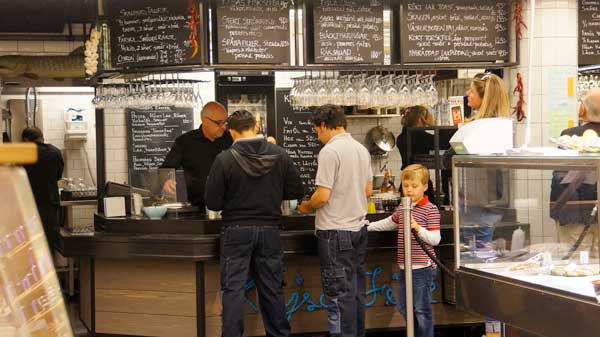
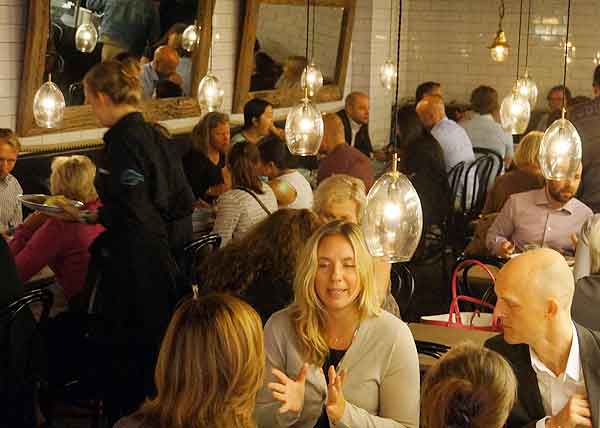
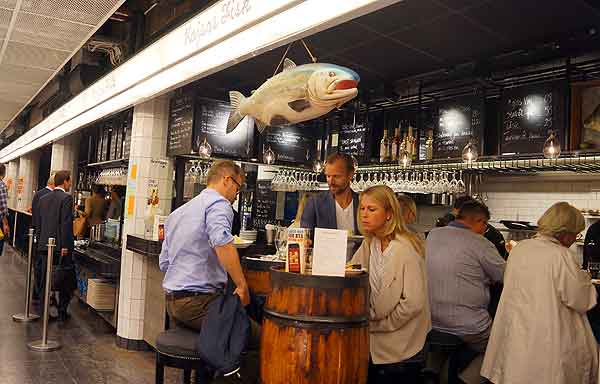
Pig organ soup

Here’s a restaurant in Singapore I didn’t try. In addition to its famous pig organ soup, the specialty restaurant pushes portions of pig livers, pig feet, pig stomach, pig uterus, pig spine meat, pig kidney, and “meat balls.” The unspeakable mystery and horror of “meat balls” is transcended by the promoted delicacies.
Indulge in any of this offal with a side of rice or a choice of noodles. Can’t decide? Choose pig fried rice, or take your chances with “Double Delight.”
I’m an adventurous eater when I travel, but I do draw lines. Nothing with four legs. Nothing with a mother. And nothing directly hot-wired to the ick factor. Pig parts are out on three counts.
Pickpocket steals from jacket on cafe chair
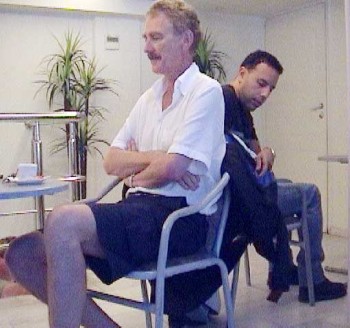
A strategist thief is one who creates his own opportunity, one who operates on a specific plan, one who steals with malice aforethought. The lowest strata of these are not much more than glorified opportunists. To me, though (and these are my definitions), an opportunist with a clever enough scheme gets a strategist rating.
Take Yacine, a north African illegal immigrant thief who works in Athens, Greece.
“I have a favorite technique to use in restaurants,” he told us, “but it only works in winter, when men hang their jackets on the backs of their chairs. I could show you, but I don’t have a jacket, and you don’t have a jacket. No one has a jacket in Athens in the summer.” He hunched his shoulders, raised his palms.
“We’ll go buy one,” Bob Arno said, and we had Yacine lead us to a men’s shop. There followed a hilarious scene in which a pickpocket selects a sport coat based on an analysis of its array of pockets. When a suitable jacket was purchased, Yacine chose a quiet café for our demonstration. Two of his colleagues joined us for lunch first, during which a cell phone rang.
Harik, 28, illegally visiting from Albania, pulled a phone out of his pocket and put it on the table. Then another, and another. He had half a dozen cell phones on the table before he found the ringing one. It had been a lucrative morning for Harik. He opened the back of the phone and pulled out its SIM card. The ringing stopped. Harik tore the tiny chip into shreds.
(An aside: want to buy a cell phone in Athens? Hundreds of men stand packed in a pedestrian shopping lane in the Plaka area, each displaying a phone or two. If you show interest in a man’s wares, he’ll pull from his pockets his other offerings, up to a dozen phones.)
“The new jacket is yours, but I need a jacket also, for this method,” Yacine said as he set the scene. “I’ll use a shirt for the demonstration.”
Pickpocket steals from jacket on cafe chair
He arranged Bob and me in bentwood chairs at a café table and ordered Greek coffee for us. He settled himself at the next table. Then, back to back with Bob, hand behind his back but hidden between the jackets, he snagged the wallet. I was facing him and saw nothing suspicious.
“You be the victim, Bob. Here’s the jacket. Put some euros in your wallet, empty is no good. Now put it in the new jacket. I don’t care which pocket! That is never something I decide. Now hang the jacket on the back of your chair. Perfect. Now, please. Have a seat. Drink your coffee.
“I will take the seat behind you so we are back to back. I have this shirt in my backpack, which I can use to simulate a jacket. I’ll hang it on the back of my chair. Now Bob, here is the secret: I will readjust the chairs so they are not exactly back to back. I’ll slide mine a little left or a little right. It doesn’t matter which way.
“Look now. I’m sitting right behind you. Our jackets are back to back on our chairs. I just slip my hand behind me and into your jacket. I don’t turn around. I can feel the pockets and quickly remove the wallet. See?

“You think that’s good? Thank you. Put the wallet back and I’ll show you something better. This is my best take. I will get the money only. I will not take the wallet. Just the money from it. It’s the same technique, but it takes a few seconds longer. Look now, I’ve got it!
“When I do this, the man never even knows. He thinks he spent the money somewhere. Very good, no?”
Yacine is an opportunist because he needs a fool for a mark, someone who’s left himself open. But he works with a strategy that gives him an advantage over the ordinary opportunist, so he has a wider field of potential victims. He’s more dangerous than his lesser fellows because he succeeds within the perceived shelter of upscale commercial establishments. He also has grander conceits. Yacine’s ultimate goal is America.
Excerpt from Travel Advisory: How to Avoid Thefts, Cons, and Street Scams
Chapter Seven: Scams—By the Devious Strategist
The Pickpocket’s postcard trick

Kharem is another opportunist who doubles as a minor-league strategist. When we first met him, he was prowling the perimeter of a breakdance performance near the top of La Rambla. He carried a black plastic bag to cover his hand as he unzipped the duffel-bags of spectators.
“My job is pickpocket. I have this job seventeen years,” he said in English, over coffee in a little restaurant, then launched into French, telling us that he worked in Paris for twelve years until he was expelled from France. He left a little girl there.
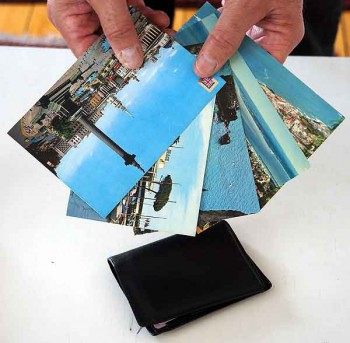
Kharem raised the plastic bag from his lap and put it on the table. He had a “unique technique,” he explained, his own method, something he invented and believes he is alone in using. He opened his plastic bag to show a handful of Barcelona postcards. He fanned the postcards and extended them to me across the table, as if offering them for sale. Then he withdrew them, leaned back in his chair with satisfaction, and tipped up the cards. Beneath them, he’d swiped my empty coffee cup.
He does this on La Rambla, Kharem told us with pride, where he approaches diners at outdoor cafés. When he removes the fan of postcards, he takes a wallet or camera with it.
Apparently, Kharem doesn’t realize that this is a fairly common technique used in internet cafés. Websurfers, intent on their email or gaming, often set a wallet, credit card, or cellphone on the desk in front of them, beside the keyboard. Perhaps Kharem did invent the postcard trick, but he’s not alone in using it. This “unique technique” vanishes so many valuables from right under noses that many internet cafés flash warnings on screen.
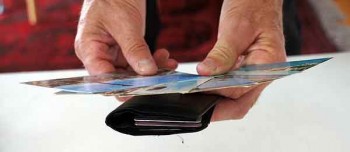
That’s how Jennifer Faust, of Canada, lost her wallet. She had it next to her keyboard at Easy Everything internet point on La Rambla. Jennifer, though, had filled out our Theft First Aid form, and therefore easily canceled her credit card accounts. Still, in the hour that passed while she fetched her Theft First Aid sheet, about $100 had been charged to one of her cards. This particular internet point, now called Easy Internet, has over 350 terminals in long rows, and the facility is open to anyone who cares to wander in. On our visits there, we spotted several teams, at different times, carrying packs of dog-eared postcards.
Excerpt from Travel Advisory: How to Avoid Thefts, Cons, and Street Scams
Chapter Seven: Scams—By the Devious Strategist
Interview with Kharem
Kharem: Confessions of an Airport Thief
Kharem: Multi-talented Thief
Travel. Glamorous?

Contrast Mamak with our New Year’s day dinner at Appetito, also in Sydney. Recommended by two people, nearby—and most important: open—it seemed a reasonable choice, if not exciting.
The sourpuss staff seated us promptly, took our drink orders, and quickly brought our glasses of wine. From there on it was all downhill. Granted, we were tired, having slept only after the people in the room next to ours checked out—or were arrested—sometime after daylight broke.
Noisy parties might be expected on New Year’s eve, even in an airport hotel. But that’s not what went on at the Sydney Ibis. Its paper walls projected every groan, cry, and vulgarity uttered by our neighbors, and of course their fighting, shouting, wall-punching, and door-slamming. All night.
SLAM! “Get your ass back here, you fucking junkie!” Sob. Whack. SLAM!
The couple moved to the parking lot outside our windows, where they joined others for rollicking beer festivities laced with anger. We later learned the others were traveling companions staying in rooms on other floors.
There were sirens. Police. Ambulance. The woman “was hurting herself.”
Here’s the problem. The Sydney Ibis Airport hotel has no onsite security. It contracts with an outside company, but pays for each “house call.” The hotel’s night manager, who received nighttime complaints from many others in addition to us, was loathe to spring for an officer call and confronted the rowdy couple directly; and only much later called police.
So we may have been a bit cranky as we waited 40 minutes for our New Year’s day dinner. It was an appetizer of seafood frito misto and two pizzas—all quick items to prepare. They weren’t bad. Nothing special, either. Certainly not worth the $102 bill. The place left a bad aftertaste. There must have been many, many better choices.
Research is vital. So is a decent night’s sleep.
Travel: not always what it’s cracked up to be.
Mamak Malaysian restaurant, Sydney

Mamak is worth standing in line for. Bob and I waited 50 minutes for what is actually rather ordinary Malaysian food. But you can’t get these dishes just anywhere, and here, they’re done to perfection. I’d call this restaurant perfect in every way my single visit allowed me to experience. Let’s start with the entertainment on offer…

After standing in line for 30 or 40 minutes, you finally creep up to the glass wall of the kitchen. Two roti-makers work like machines at their stainless steel counter, stretching small balls of dough by flinging them over their heads until they look like giant, translucent handkerchiefs. You just know one is going to become a kite and sail onto the head of a grill cook. Or one will rip and fly into shreds. They never do. After the final toss, the dough lands on the counter stretched into the size of a sheet of newspaper.
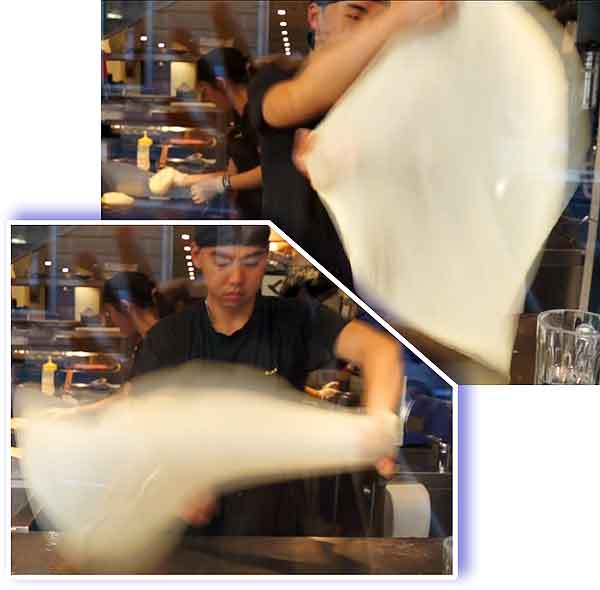
That’s when the roti is given it’s specific form. It might be quickly folded into an air-filled pillow and simply thrown on the grill, where cooks hover over the rotis, pressing them, flipping them, and rushing them off to drooling diners. Or the dough might first get a sprinkling of red onions. Bob and I ate rotis often when we lived in Singapore. In their most basic form, they’re simple flat breads served hot off the grill with a bowl of curry sauce for dipping.
A filled (and filling) version is called murtabak. An egg is broken onto the stretched dough, which is then topped with a smear of curry sauce, a toss of onion shreds, and possibly shredded chicken, mutton, or sardines. The gossamer dough is folded into a many-layered square, cooked on the grill, and served steaming hot with a bowl of spicy curry sauce. Perfection! Mamak serves murtabak. I wish I could have tried it, but we ordered other items.
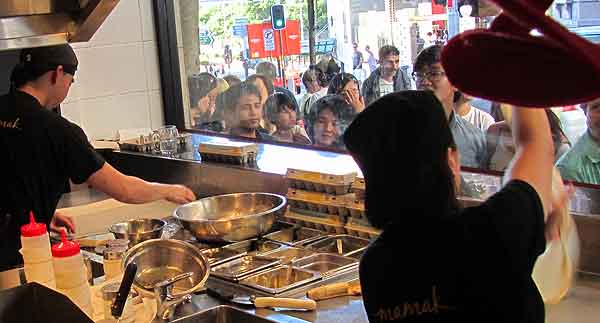
I’d gotten a menu to look at while in line, so we’d be ready to order right away. That’s the one tiny improvement that could speed Mamak’s turnover just a tad: menus outside so diner’s can use the waiting time to peruse the offerings.
When you finally enter the restaurant, all primed for a roti (but which one???), the fragrance of baking bread slays you. The urgency of the cooks and waiters increases your heart rate and your stomach announces its presence and desires. Luckily, Mamak is fast! Your order is in and out in moments.
Mamak cooks a small selection of Malaysian dishes (most of which are traditional street foods) which keeps the menu from overwhelming people unfamiliar with the cuisine. They do a variety of rotis, two kinds of satay, several curries and stir-fries, and spicy-fried chicken. There’s the classic nasi lemak, which is fragrant coconut rice with condiments (which we ordered), and a couple of fried noodle dishes.

We also ordered rojak. I’ve had it many times in Singapore, but never like Mamak’s. Typically a salad of crisp and crunchy fruits and vegetables, julienned yambean and cucumber, fried tofu, and prawns, it’s coated with a spicy peanut sauce and garnished with hardboiled eggs. Mamak’s version was heavy on the sauce, sweet, tall, and… delicious.
Crisp and fluffy roti cania looked to be the most popular item on the menu. So simple, yet so satisfying. You lick your finger to pick up every last flake of the toasty bread.
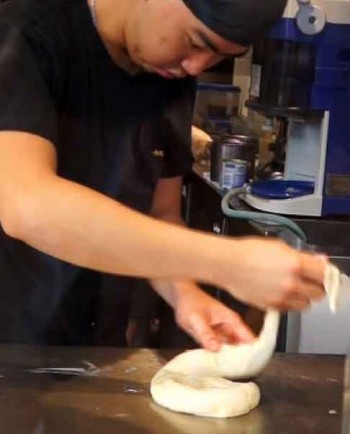
The rich and exotic roti planta requires a time-consuming process. Twenty or so little dabs of butter are spaced out along one edge of the stretched dough sheet. The sheet is then rolled into a lumpy, air-filled snake, the buttery dots along its length like undigested mice. The fragile tube is then carefully coiled like a sleek-skinned cobra, and set on the grill to crisp, melt, sizzle, and brown.
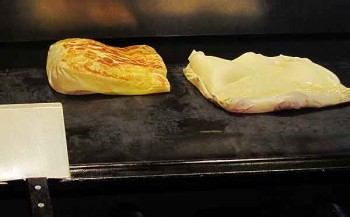
Mamak also offers a variety of Malaysian tea and coffee drinks, and two typical desserts: ice kachang and chendol. I ADORE chendol, a complicated ice dessert composed of many ingredients. Instead of trying it here though, Bob and I chose to go next door to the Taiwanese dessert shop called Meet Fresh. Yeah, funny name! I got “handmade taro-balls #4” with peanuts (soft), pearls, and red beans. I could have ordered it hot, but chose to have it over ice. Bob got mango sago coconut soup.
Taro-balls #4 was nice, but it’s no chendol. Come to think of it, chendol needs a post of its own. I dream of chendol, but only a certain kind. It must be topped with one particular fruit. I will tell you… soon!
In addition to the selection and quality of its food, Mamak gets a gold star for speed. Our meal arrived eight minutes after ordering it. When we left, the line was as long as when we got into it an hour and a half earlier. And guess what? After we finished dessert next door? Yep, the Mamak’s line was even longer.
On Goulburn at Dixon in Haymarket, on the edge of Sydney’s Chinatown, Mamak is a winner.
Japanese kaiseki dinner
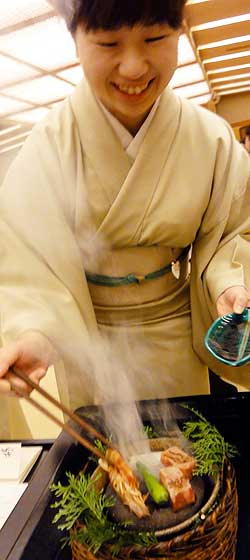
You are lucky indeed if you ever get the opportunity to experience a kaiseki meal, especially one in a ryokan, a traditional Japanese inn. You’ll enjoy a long, relaxed procession of delicacies in small portions, exquisitely presented, and usually specific to the season.
I had the incredible good fortune to indulge in a week of kaiseki lunches and dinners in Japan. One meal featured tofu in many forms. One featured tempura. Another was Buddhist vegetarian. The most breathtaking were those served at Yagyuno Sho Ryokan in Shuzenji, on Japan’s Izu peninsula.
I’m in awe of Takashi Shibayama, Yagyuno Sho’s chef, who showcased an endless variety of glorious creations in perfect balance, meal after meal. As you’ll see in the following photos, his magnificent presentations are the synergetic result of his ravishing edible works of art complemented by precious serving pieces, and owe a nod to whimsy.
These photos are from a single kaiseki dinner titled “A Picnic Under the Cherry Blossoms.” A menu was provided in Japanese calligraphy, along with an attempted English translation.
One Kaiseki dinner
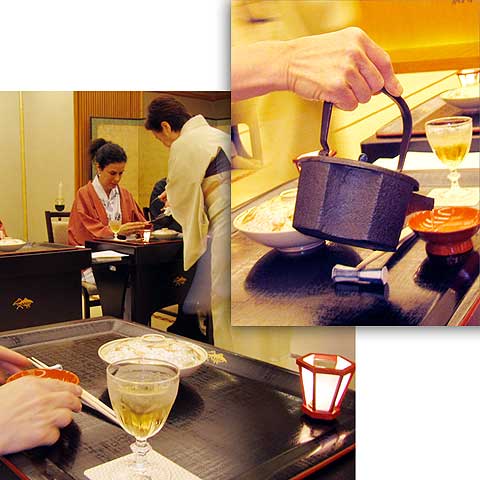
The meal begins with a treasured sake poured from iron pots into flat red lacquer bowls. Just a sip, it’s a fruity and fervent taste bud wakeup call, accompanied by a tiny red lantern glowing with a short-lived candle. In a deeply-textured covered bowl, a surprise awaits.

Surprise indeed! Who would expect haute cuisine—and foie gras, no less? It’s a silky paté “with white radish agar (moon) and salty meringue (cloud),” a garnish of gold foil and cherry blossom petals—an edible haiku in beige. How about…
Fat goose flies in spring
Cherry blooms, moon in cloud, his
Liver is dinner
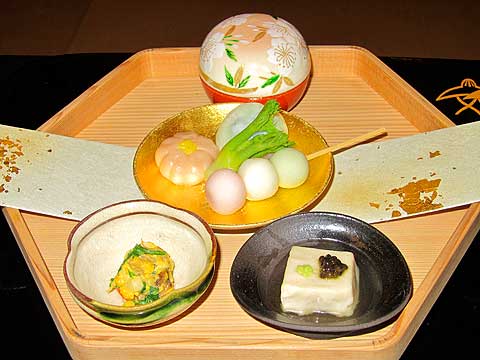
A wooden tray is presented. Paradoxically called “Simple Meal,” it is anything but. In the gorgeous little covered bowl: “bamboo shoot, udo, butterbur dressed with young Japanese pepper and moso.” In my excitement, I forget to take a picture of the opened bowl. The central plate of gold-leaf floats on a gold-leaf-spattered strip of handmade paper. It holds “sushi balls, picnic dumpling, and dried wheat.” On the black ceramic dish, sesame seed tofu with caviar. In the beige: “rape blossoms with dried wheat gluten.”
Gluten makes frequent appearances. Itself bland with a pleasant, chewy texture, it’s an excellent sponge and carrier of flavors.

Our cold sake arrives in crystal glass decanters deep in red lacquer bowls of ice and flowers. You must not pour your own sake—but look after your neighbors, and make sure their cups are full. I can’t help noticing the uniformity of the ice—crushed to perfection.
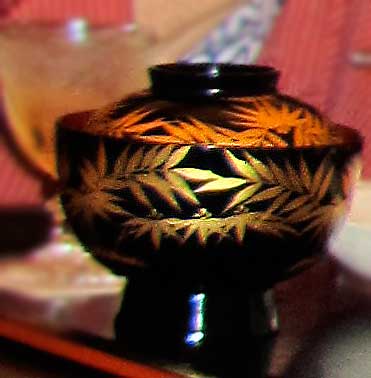
A small “clear soup with red sea bream dumpling” is in a large lacquer bowl, black with gold bamboo on the outside, dark red on the inside. We are reminded that we are not expected to like or consume everything, but I can’t help myself. I do and I do.

Boat-shaped dishes with tantalizing covers are set before us. Our chopstick rests are swapped for porcelain cherry blossom petals. We begin to wonder how large the ryokan’s tableware pantry is.

Lifting the bamboo roofs, we discover sashimi: tuna, sole, and horse clam. We’re gently instructed on which condiment highlights each fish. All the garnishes are edible, including the cherry blossoms.
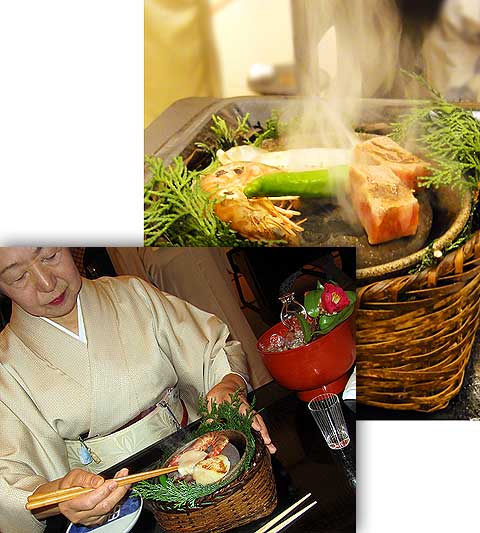
Done with delicate for the moment, a hot rock is brought to each of us wrapped in fresh juniper branches in a wicker basket. We are served at meals by the same women who look after our rooms, and now they cook for us. Izu beef, shrimp, squid, and a green chili pepper are placed on each heated stone, which sears the food in a minute or two. I get two fat scallops instead of beef.

These colorful popsicles are called dengaku: “grilled tofu and dried wheat gluten on skewers coated with miso glaze.” They’re balanced on a bamboo cane on a rough plate the color of bamboo.The plate is a mossy pond whose surface is disturbed by koi kissing air.

Steamed icefish on sea urchin. The tiny white fish are complete with little eyes. The beautiful bowl and urchin-colored saucer are paper thin. We’ve learned to recover our bowls when finished with a dish. The staring fish and raw sea urchin gonads are too much for some; their bowls are quickly covered.

“100% fresh tomato juice.” It is thick enough to eat with a wooden spoon, and very cold in a crystal shot glass. A concentrated flavor break between two hot dishes.

In a brown and gold covered lacquer bowl, “deep fried bamboo shoot with liquid starch.” There must be a better translation for “liquid starch,” but the Japanese haven’t found it. Enriched broth? Thickened consommé?

This one has an element of mystery. The menu translation is “dark brawn miso soup with bean curd tofu skin.” Is that dark brown soup or dark prawn soup? Either way, it is delicious. Ahhh… another bottle of sake, please!
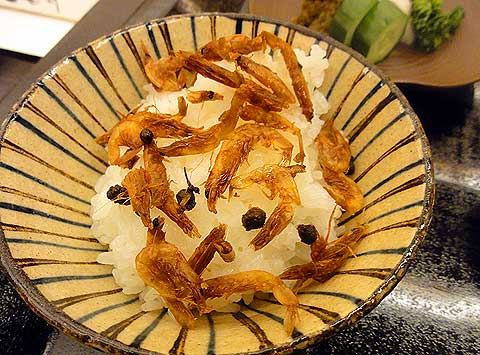
Finally, and always last, comes the rice. It’s in a stunning stoneware bowl with an accompaniment of cooked small shrimp. A plate of pickled vegetables on the side.
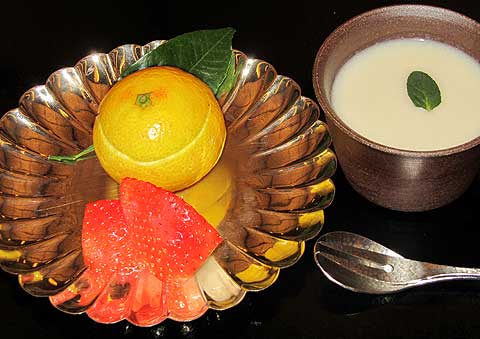
And for dessert, something small, cold, and light on a silver dish. “Sweet summer yellow orange,” a strawberry for contrast, and a sweet drink made from fermented rice with soybean milk pudding.
Breakfasts at the ryokan are just as spectacular, but served expeditiously, in well over a dozen different little plates and bowls. I’ll spare you the photos.
Over five dramatic meals on the property, I never saw the same serving piece more than once. And all of this was managed just days after the earthquake and tsunami, under the threat of nuclear meltdown, between scheduled rolling blackouts. Praise and thanks to Yagyuno Sho Ryokan and its wonderful chef and staff.
* * *
Read about Japan’s complicated shoe rules.
Read what it was like to be in Japan’s 9.0 earthquake.
Bad behavior in Cairo
I’m mortified to remember the time I refused to shake hands with an Egyptian.
It’s a sad commentary on the state of the world when one must look at every stranger with distrustful eyes, and in some ways it defeats the whole purpose of leisure travel. Spectacular landscapes, ruins, markets, shops, and food are only the skin of a culture. Its people are its core. Around the world people are attracted to people; locals are warm and welcoming to travelers, and swell with national pride. In many countries, to refuse a gift is to insult your host. In some countries, insulting your host is provocative indeed.
After a long hot morning interviewing the Cairo police, we returned to our hotel to wash up. We then intended to visit the American Express office at the Nile Hilton, and from there, we’d hunt down an excellent Egyptian lunch at the Khan el Khalili Bazaar. Refreshed, we made our way through thick air, deafening noise, and teeming crowds to the 6th of October Bridge, which spans the Nile.
Policemen at attention stood the length of the bridge, perfectly spaced every thirty feet, rigid and regular as toy soldiers. They were armed, however, like real soldiers. I asked an important-looking officer who appeared to be supervising the formation. “Is it always like this? Are there this many officers every day?” No, President Mubarak is coming, he said. At the end of the bridge we paused and looked up to locate the Nile Hilton.
“You can’t cross the street here,” a friendly local volunteered. “If you try, the police will only stop you. Our president is coming, you see.” He was curly-headed, short, chubby, and a bit rough.
“How do we get across to the Hilton?” Bob asked.
“You must use the underpass. Come, I’ll show you.” As we turned, the entry to the underpass became obvious. We thanked the man, but he wasn’t finished with us.
“Hello,” he kept saying. “How are you? Where are you from? You like Cairo?” He offered his hand, and Bob shook it politely as the three of us walked toward the underpass.
“Lady, what’s your name?”
“Bambi,” I said, walking ahead. I smiled at him over my shoulder, hoping he’d find me friendly but in a hurry. I had no wish to offend him, but I am not fond of shaking hands with any stranger on the street.
“Hello!” he persisted. I increased my pace slightly. That turned out to be an unwise move; thoughtless and undiplomatic.
“You don’t want to shake hands with an Egyptian? I am your host! Do you think I’m dirty?”
“My wife has a cold,” Bob lied, “she doesn’t want you to get it.”
“Perhaps she doesn’t like Egyptians! What kind of visitors are you!”
I felt terrible by then, and regretted my rude and tactless behavior when I should have been on my best. But now I was concerned about the man’s escalating verbal assault. He was still walking with us and, as the underground passage loomed ahead, the chicken in me pecked holes in my nerves. I should have turned and apologized. Instead, I sped up.
I heard Bob behind me, trying to explain the transference of germs from hand to hand to mouth and the Cairene not getting it. As I entered the tunnel, Bob not far behind, the agitated man gave up and dropped us. I was relieved and ashamed at the same time.
Later, we unwound in a barely-lit alcove of the cave-like back of the elegant Khan El Khalili Restaurant. The front of the restaurant, called the Naguib Mahfouz Coffee Shop for the Nobel Prize-winning novelist, was all about unwinding. Customers slouched among pillows sucking on hookahs, dark coffee and sweet smoke scented the room, narrow shafts of harsh sunlight illuminated the thick swirling air, and waterpipes burbled like aquariums.
In the back it was quiet, private, and dramatically lit. Over little plates of olives, babaganoush, hummus, and flat bread, we reflected on the encounter. It could have gotten out of hand; we were lucky. But why had I behaved so badly? What had repelled me from the one-man welcome committee? Was I just too street-smart, smelling a scam? Had years of thief-patrol put me off all humanity?
No, I lacked any credible excuse. I had just washed, was on my way to eating lunch with my hands, and just plain didn’t want to shake hands. Shame on me. I felt miserable, but allowed myself to be soothed by the atmosphere and luscious meal.
Encounters with locals can offer the deepest, longest-lasting memories of a trip. But when cultures collide, sensitivity and caution must be in balance. Judgment is critical, but how can we determine what our own behavior should be, with little understanding of foreign sentiment? A majority of Americans, cocooned as we are in our huge world of a nation, have a myopian global perspective, as limited as that of an Amazonian tribesman or a Mongolian herder. Our collective ignorance of political issues stuns smaller nations, which can’t afford to know only their own business.
Our naiveté may occasionally lead to confrontations such as mine with the Egyptian. It can also foster dangerous hostility, and it allows us to walk into scams, swindles, and set-ups.
Excerpt from Travel Advisory: How to Avoid Thefts, Cons, and Street Scams
Chapter Three: Getting There—With all your Marbles
Scams at restaurant tables
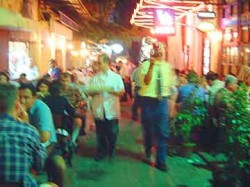
A restaurant table is a good place to be had. The latest in low-tech scams happened last month in Hoboken, NJ, when a man appeared tableside to collect cash after diners had received their bills. He took their money and walked out the door. Pretty clever.
Why didn’t the customers question the new face? I can answer that, as one who visits restaurants some 200+ days a year. Sometimes we just don’t pay attention to who’s serving us. We’re seated by a host, served water by a busboy, solicited by a sommelier, finally the waiter comes, and sometimes we’re greeted by a manager. The meal might be a business meeting which demands our attention more than faces.
Last week, I had a long, late lunch at Postrio in Las Vegas. When our waiter’s shift ended, she did what customer service people call a “warm hand-off:” she introduced us to the waiter who would continue with us. She could have just left, and when the replacement waiter showed up, we’d have just accepted him.
So the Hoboken bogus waiter simply took advantage of our innate trust. He manipulated his victims by presenting himself as the person they expected; he didn’t even have to say anything. Hand out, money in, bye-bye.
So what did the restaurant do when the customers told the real waiter that they’d already paid someone else? Management did not make them pay again. Which invents an entirely new scam: diners claiming they already paid the bill (even though they haven’t). Perhaps the bogus waiter plans that as his next trick.
In the case of the bogus waiter, the victims were not out-of-pocket due to the goodwill of the restaurant management. Other potential losses while dining out:
-
…¢Your phone or other valuables can be sneakily swiped from the table top.
…¢Your bag or briefcase can be snatched.
…¢Your purse can be swiped right off your lap.

